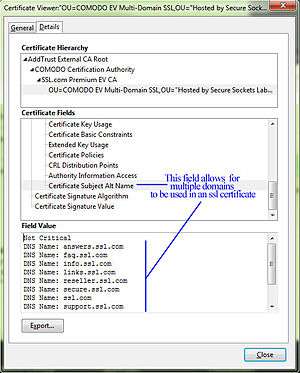Wildcard certificate
In computer networking, a wildcard certificate is a public key certificate which can be used with multiple sub-domains of a domain. The principal use is for securing web sites with HTTPS, but there are also applications in many other fields. Compared with conventional certificates, a wildcard certificate can be cheaper and more convenient than a certificate for each sub-domain. Multi-domain wildcard certificates further simplify the complexity and reduce costs by securing multiple domain and their sub-domains.


Example
A single wildcard certificate for https://*.example.com will secure all these subdomains on the https://*.example.com domain:
payment.example.comcontact.example.comlogin-secure.example.comwww.example.com
Instead of getting separate certificates for subdomains, you can use a single certificate for all main domains and subdomains and reduce cost.[1]
Because the wildcard only covers one level of subdomains (the asterisk doesn't match full stops),[2] these domains would not be valid for the certificate:
test.login.example.com
The "naked" domain is valid when added separately as a Subject Alternative Name (SubjectAltName):[3]
example.com
Note possible exceptions by CAs, for example wildcard-plus cert by DigiCert contains an automatic "Plus" property for the naked domain example.com.
Type of wildcard certificates
Wildcard certificates are categorized on the basis of validation level, number of domain and number of servers it can be used with. Likewise they are named as domain validation wildcard certificate, organisation validation wildcard certificate and extended validation wildcard certificate when we categorize them according to validation level. The name Multi-domain wildcard certificates and Multi-server wildcard certificates are given according to number of domain and number of server. All types of wildcard certificates signed by popular CAs are categorized and listed internet. Therefore there are types of wildcard which can secure multiple domains, multiple servers and provide different levels of validation.
Limitations
Only a single level of subdomain matching is supported in accordance with RFC 2818.[4]
It is not possible to get a wildcard for an Extended Validation Certificate.[5] A workaround could be to add every virtual host name in the Subject Alternative Name (SAN) extension,[6][7] the major problem being that the certificate needs to be reissued whenever a new virtual server is added. (See Transport Layer Security § Support for name-based virtual servers for more information.)
Wildcards can be added as domains in multi-domain certificates or Unified Communications Certificates (UCC). In addition, wildcards themselves can have subjectAltName extensions, including other wildcards. For example, the wildcard certificate *.wikipedia.org has *.m.wikimedia.org as a Subject Alternative Name. Thus it secures www.wikipedia.org as well as the completely different website name meta.m.wikimedia.org.[8]
RFC 6125 argues against wildcard certificates on security grounds.[9]
Examples
The wildcard applies only to one level of the domain name.
label.label.label.TLD
*.domain.comis OK. It will matchwww.domain.combut notdomain.comand notzzz.www.domain.com
The wildcard may appear anywhere inside a label (aka "partial-wildcard")[10]
f*.domain.comis OK. It will matchfrog.domain.combut notfrog.super.domain.com
baz*.example.netis OK and matchesbaz1.example.net*baz.example.netis OK and matchesfoobaz.example.netb*z.example.netis OK and matchesbuzz.example.net
(However, note that all major browsers deliberately do not support "partial-wildcard" certificates; they will result in a "SSL_ERROR_BAD_CERT_DOMAIN" error. Similarly, it is typical for standard libraries in programming languages to not support "partial-wildcard" certificates. For example, any "partial-wildcard" certificate will not work with the latest versions of both Python and Go. Thus, use of "partial-wildcard" certs is not recommended.)
Do not allow a label that consists entirely of just a wildcard unless it is the left-most label
sub1.*.domain.comis not allowed.
A cert with multiple wildcards in a name is not allowed.
*.*.domain.com
A cert with * plus a top-level domain is not allowed.
*.com
Too general and should not be allowed.
*
International domain names encoded in ASCII (A-label) are labels that are ASCII-encoded and begin with xn--.
Do not allow wildcards in an international label.
xn--caf-dma.comiscafé.comxn--caf-dma*.comis not allowedLw*.xn--caf-dma.comis allowed
References
- "Wildcard Certificate Explained in Simpler Terms". 23 May 2016.
-
"RFC 2818 - HTTP Over TLS". Internet Engineering Task Force. May 2000. p. 5. Retrieved 2014-12-15.
[...] *.a.com matches foo.a.com but not bar.foo.a.com.
-
"RFC 2595 - Using TLS with IMAP, POP3 and ACAP". Internet Engineering Task Force. June 1999. p. 3. Retrieved 2014-12-15.
For example, *.example.com would match a.example.com, foo.example.com, etc. but would not match example.com.
- Wildcard SSL certificate limitation on QuovadisGlobal.com
-
"Guidelines For The Issuance And Management Of Extended Validation Certificates, Version 1.5.2" (PDF). CA/Browser Forum. 2014-10-16. p. 10. Retrieved 2014-12-15.
Wildcard certificates are not allowed for EV Certificates.
- x509v3_config Subject Alternative Name
- The SAN option is available for EV SSL Certificates on Symantec.com
- SSLTools Certificate Lookup of Wikipedia.org's wildcard ssl certificate
-
"RFC 6125 - Representation and Verification of Domain-Based Application Service Identity within Internet Public Key Infrastructure Using X.509 (PKIX) Certificates in the Context of Transport Layer Security (TLS)". Internet Engineering Task Force. March 2011. p. 31. Retrieved 2014-12-10.
This document states that the wildcard character '*' SHOULD NOT be included in presented identifiers but MAY be checked by application clients (mainly for the sake of backward compatibility with deployed infrastructure). [...] Several security considerations justify tightening the rules: [...]
- Rescorla, E. (May 2000). "RFC 2818 - HTTP Over TLS". tools.ietf.org. Retrieved 2019-04-20.
Relevant RFCs
- "RFC 2595 - Using TLS with IMAP, POP3 and ACAP". Internet Engineering Task Force. June 1999. p. 3.
- "RFC 2818 - HTTP Over TLS". Internet Engineering Task Force. May 2000. p. 5.
- "RFC 6125 - Representation and Verification of Domain-Based Application Service Identity within Internet Public Key Infrastructure Using X.509 (PKIX) Certificates in the Context of Transport Layer Security (TLS)". Internet Engineering Task Force. March 2011.